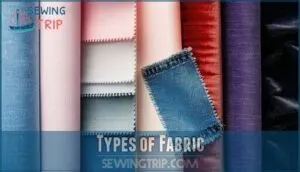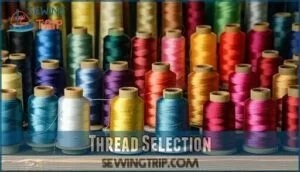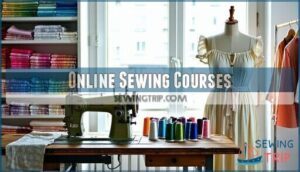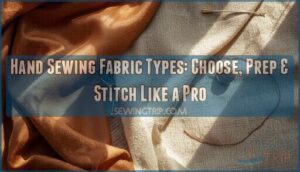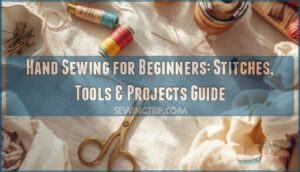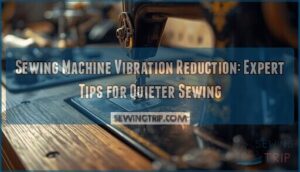This site is supported by our readers. We may earn a commission, at no cost to you, if you purchase through links.
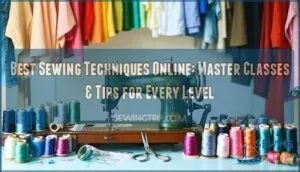 You’ll discover the best sewing techniques online through structured video courses on platforms like Skillshare, Creativebug, and Udemy.
You’ll discover the best sewing techniques online through structured video courses on platforms like Skillshare, Creativebug, and Udemy.
These sites offer everything from basic hand stitches to advanced machine techniques like princess seams and gathered skirts.
Start with beginner-friendly tutorials that cover essential tools, fabric selection, and threading basics.
Interactive lessons let you pause, rewind, and practice at your own pace.
Many platforms provide downloadable patterns and supply lists too.
Whether you’re mastering buttonholes or tackling complex garment construction, online courses break down intimidating techniques into manageable steps.
The secret lies in choosing courses that match your current skill level and specific project goals.
Table Of Contents
Key Takeaways
- You’ll master sewing faster by starting with structured online courses on platforms like Skillshare, Creativebug, and Udemy that offer step-by-step video lessons you can pause and replay at your own pace.
- You need quality basic tools first—sharp fabric scissors, various needles, thread cutters, and seam rippers—since the right equipment makes the difference between frustrating struggles and smooth results.
- You should match your thread type and needle to your fabric’s properties, understanding that cotton blends work best for beginners while specialty fabrics require advanced techniques and specific handling.
- You can progress from basic hand stitches to advanced machine techniques like princess seams and gathered skirts by choosing courses that match your current skill level and practicing consistently with simple projects first.
Best Sewing Techniques
You’ll master essential sewing skills faster when you start with the right foundation of tools, supplies, and structured online lessons.
Learning proper techniques from the beginning saves you time and frustration while building confidence for more advanced projects, and this approach helps you to learn faster.
Basic Sewing Tools
With the right sewing tools, you’ll create beautiful projects effortlessly.
Quality tools make all the difference between frustrating struggles and smooth, professional results.
Essential basics you need:
- Fabric scissors – Sharp blades dedicated solely to cutting fabric (scissors comparison shows quality matters)
- Sewing needles – Various needle types for different fabrics and techniques
- Thread cutters – Precise snipping without damaging your work
These sewing tools form your foundation.
Finding the best fabric scissors is essential for clean cuts.
Many sewers start with sewing kits containing multiple sewing supplies and sewing notions, making notion uses clearer as skills develop.
Essential Sewing Supplies
Building your sewing supplies arsenal starts with sharp fabric scissors—never use them on paper.
Stock up on sewing needles for different fabrics, plus thread cutters for clean snips.
Essential notions include seam rippers for fixes, needle threaders for easier threading, thimbles for finger protection, pattern weights to hold pieces steady, and fabric marking tools for accurate cuts.
Consider blade material options for your scissors to maximize their lifespan.
These sewing tools form your reliable foundation.
Online Sewing Lessons
You’ll find online sewing lessons transform your skills through flexible, self-paced learning.
Transform your stitching from shaky beginner seams to polished, professional results through flexible online learning.
Platforms like YouTube, Skillshare, and Udemy offer free online classes covering pattern comprehension, seam finishing, and garment construction.
These online sewing courses teach digital patternmaking and project customization, letting you master sewing techniques online at your own speed.
They also provide resources for learning accurate measurement techniques for tailoring, and help you master sewing techniques online.
Sewing Machine Operation
Master your sewing machine operation by understanding the fundamentals that separate smooth stitching from frustrating tangles. Whether you’re tackling your first hem or crafting complex garments, these core elements determine your success.
Stitch Selection and Needle Types work together—match your needle to fabric weight and choose appropriate stitches for each project. Foot Attachments expand your capabilities, from zipper feet to buttonhole attachments. Fabric Feeding requires proper pressure and speed control to prevent puckering or skipped stitches.
Here’s what separates beginners from confident sewers:
- Tension mastery: Balanced tension creates even, professional-looking seams without puckering
- Threading precision: Proper threading prevents jams and guarantees consistent stitch quality
- Speed control: Slow, steady stitching beats racing through seams any day
Regular Motor Maintenance keeps everything running smoothly. Clean lint buildup, oil moving parts, and replace needles frequently. Many find that automatic needle threading simplifies the sewing process.
Sewing machine tutorials and sewing machine troubleshooting guides help you master these sewing machine basics through hands-on practice and expert sewing machine techniques.
Working With Fabric
Understanding fabric is essential for successful sewing projects since different materials behave uniquely under your needle.
You’ll need to match your thread choice and sewing technique to each fabric’s specific properties to achieve professional-looking results.
Types of Fabric
Choosing fabric types can make or break your sewing project.
Cotton blends offer fabric durability and forgiveness for beginners, while silk adds elegance to special pieces.
Understanding fabric properties helps you match materials to your vision.
Woven fabrics like denim provide structure, while knit fabrics offer stretch and comfort.
Fabrics are primarily categorized by woven or knitted construction impacting their properties.
Specialty fabrics like velvet require advanced skills but deliver stunning results.
Smart fabric selection sets you up for sewing success.
| Fabric Type | Key Properties | Best Projects |
|---|---|---|
| Cotton Blends | Durable, easy to sew | Everyday garments |
| Knit Fabrics | Stretchy, comfortable | T-shirts, activewear |
| Woven Fabrics | Stable, structured | Shirts, pants |
| Silk | Luxurious, challenging | Formal wear |
| Specialty Fabrics | Unique textures | Statement pieces |
Thread Selection
Now that you’ve got your fabric types down, thread selection can make or break your project. The right thread choice transforms good sewing into great results.
Smart sewers know that Thread Weight affects everything from seam strength to stitch appearance. Fiber Types like polyester offer durability, while cotton provides natural grip. Color Matching requires picking shades slightly darker than your fabric—they’ll blend beautifully into seams.
For effective results, understanding thread weight classifications is vital.
Here’s your thread selection game plan:
- Match thread types to Fabric Types—polyester for synthetics, cotton for naturals
- Consider Needle Pairing—heavier threads need larger needles to prevent breakage
- Explore Specialty Threads—monofilament for invisible stitches, embroidery thread for decorative work
Fabric Properties
After choosing the right thread, you’ll want to understand fabric properties that make or break your sewing projects.
Fabric properties determine how your material behaves under the needle and affects your finished project’s look and durability. When you understand these characteristics, you’ll pick fabrics confidently and avoid common sewing headaches.
| Property | Impact on Sewing |
|---|---|
| Drape and Flow | Controls garment silhouette and movement |
| Wrinkle Resistance | Determines pressing needs and garment care |
| Shrinkage Control | Affects pre-washing requirements |
| Breathability | Influences comfort and seasonal wear |
| Colorfastness | Prevents bleeding during washing |
Fabric density and weave type directly impact your thread selection and needle choice. Tightly woven fabrics need sharper needles, while loose weaves require gentler handling. Natural fabric types like cotton offer breathability but may shrink, while synthetics provide wrinkle resistance with less breathability.
Pay attention to these fabric properties before cutting your first piece—it’ll save you frustration later.
Online Sewing Courses
You’ll find the best online sewing courses across platforms like Skillshare, Creativebug, and Udemy, each offering unique approaches to skill building.
These platforms combine expert instruction with flexible pacing, so you can master everything from basic stitches to advanced garment construction at your own speed, which is key to master everything.
Skillshare Classes
Skillshare offers over 200 sewing-focused online sewing classes with impressive Class Variety spanning beginner hand-stitching to advanced garment construction.
Popular Skillshare classes like Denise Bayron’s "Sewing Basics" attract 17,000+ students through quality video lessons and downloadable resources.
Strong Instructor Quality from fashion professionals guarantees reliable online sewing lessons.
Community Features let you share Skillshare Projects for feedback, while Subscription Value provides unlimited access to thorough sewing techniques online for confident skill-building.
Creativebug Courses
With over 350 online sewing courses, Creativebug delivers unmatched Project Variety through its Subscription Model.
You’ll find everything from basic pattern reading to advanced couture techniques, all taught by Expert Instructors including fashion designers and professional sewists.
Their Course Structure breaks lessons into digestible chapters with downloadable patterns, while high-definition videos make complex techniques crystal clear.
This thorough approach to Skill Development transforms novices into confident sewists.
Plus, their partnership with JOANN offers material discounts, making sewing techniques online both accessible and affordable for serious learners.
Udemy Sewing Lessons
Udemy transforms sewing education with structured courses that fit your schedule.
Their expert instructors bring years of experience to each lesson, making complex techniques accessible.
Key advantages of Udemy’s approach:
- Flexible Learning: Study at your own pace with lifetime access
- Expert Instruction: Learn from seasoned professionals with proven track records
- Affordable Options: Courses range from $5.64 to $49.99 with money-back guarantees
- Practical Projects: Build real skills through hands-on assignments
- Global Access: Available worldwide on any device
Popular courses like "Sewing 101" earn 4.5-star ratings from thousands of students, proving these online sewing classes deliver results you’ll actually use.
Advanced Sewing Techniques
Once you’ve mastered the basics, it’s time to tackle techniques that’ll make your projects look truly professional.
Advanced methods like gathered skirts, princess seams, and machine-focused approaches will transform your sewing from hobby-level to couture-quality results.
Gathered Skirts
Gathered skirts teach you Volume Control and Gathering Ratios through hands-on practice.
You’ll master Fabric Choice for different drapes, create Elastic Casings for comfort, and explore Tiered Skirts for added flair.
These sewing techniques online build confidence while online sewing classes guide your progress.
Sewing courses make gathered skirts approachable, turning basic sewing techniques into stunning wearable art.
Princess Seams
Princess seams transform flat patterns into three-dimensional, flattering fits that hug your curves perfectly. These advanced sewing techniques require precision but deliver stunning results.
Master seam shaping and curve stitching for professional-looking garments. Bust fitting becomes effortless once you understand pattern alteration basics. Online sewing classes teach these skills step-by-step, making complex techniques accessible.
Here’s your roadmap to princess seam success:
- Mark notches carefully for accurate seam shaping
- Stay-stitch curves before joining pieces together
- Clip seam allowances strategically for smooth curve stitching
- Press seams toward center front for best results
- Experiment with princess variations for different silhouettes
These sewing techniques online turn basic patterns into custom-fitted masterpieces that rival designer garments.
Machine-Focused Sewing
Your machine’s potential reveals through proper tension adjustment and needle selection.
Master stitch types by practicing straight, zigzag, and decorative options.
Explore foot attachments for specialized tasks like zippers and buttonholes.
Regular machine maintenance prevents costly repairs.
Online sewing classes and machine-focused sewing tutorials teach advanced sewing techniques that transform beginners into confident sewists.
Mastering specialty presser feet allows for intricate designs.
Sewing for Beginners
Starting your sewing journey doesn’t have to feel overwhelming when you have the right online resources at your fingertips.
You’ll find countless free classes, beginner-friendly tips, and step-by-step machine tutorials that’ll turn you from fabric-fumbler to confident stitcher faster than you think.
Free Online Classes
Learning to sew doesn’t require breaking the bank.
YouTube channels like Made to Sew and Anita By Design offer thorough beginner resources with step-by-step project tutorials.
Platforms like Skillshare and Creativebug provide free trials packed with expert instructors teaching online sewing classes.
You’ll find free patterns, community forums for support, and online tutorials covering everything from machine basics to advanced techniques through these accessible online sewing programs.
Many beginners start with basic sewing skills to build a solid foundation.
Beginner Sewing Tips
Your sewing journey starts with mastering the basics—think of it as building your foundation before constructing your dream home.
- Easy Projects: Start with simple items like tote bags or pillowcases to build confidence
- Fabric Choices: Choose cotton for beginners—it’s forgiving and easy to handle
- Stitch Practice: Master straight lines before tackling curves; consistency beats speed every time
Focus on Tool Familiarity and Pattern Reading through sewing tutorials designed for beginner sewing.
Sewing Machine Basics
Your trusty companion awaits—the sewing machine! Start with threading machine basics and bobbin winding techniques.
Master tension adjustment and stitch selection for perfect seams. Machine maintenance keeps everything humming smoothly.
Sewing machine tutorials for beginners and online sewing classes guide your journey.
| Component | Purpose | Beginner Tip |
|---|---|---|
| Needle | Pierces fabric | Match to fabric weight |
| Bobbin | Lower thread source | Wind evenly for smooth stitching |
| Tension Dial | Controls thread tightness | Start at medium setting |
| Stitch Selector | Changes stitch patterns | Begin with straight stitch |
Mastering Sewing Skills
You’ve learned the basics, but now it’s time to level up your sewing game with techniques that’ll make your projects look professionally made.
Whether you’re ready to tackle hand sewing finesse, master your machine’s full potential, or jump into intermediate skills, these online resources will transform you from a nervous beginner into a confident sewist.
Hand Sewing Basics
Essential Stitches form the foundation of your sewing journey.
Master the Running Stitch for strong seams and the backstitch for durability.
Practice slip stitches to create Invisible Seams that look professional.
Don’t forget the blanket stitch—it’s perfect for finishing Fabric Edges and adding decorative touches to Hand Projects.
These sewing techniques for beginners build confidence before tackling machine work.
Sewing Machine 101
While hand sewing builds your foundation, your sewing machine becomes your creative powerhouse.
Think of it as your co-pilot—once you understand each other, you’ll create magic together.
Master these fundamentals:
- Machine Anatomy: Know your presser foot, feed dogs, and bobbin case like old friends
- Threading Guide: Follow your machine’s numbered path—skipping steps creates chaos
- Basic Stitches: Straight stitch first, then explore zigzag and buttonhole options
- Tension Settings: Balanced tension prevents puckered seams and thread breakage
- Maintenance Tips: Clean lint regularly and oil moving parts for smooth operation
Intermediate Sewing Classes
Once you’ve got the basics down, intermediate sewing classes open up a whole new world of possibilities.
You’ll tackle pattern alterations, master fitting techniques, and learn zipper installation without breaking a sweat.
These classes focus on garment construction using advanced seams and precision methods.
Online tutorials guide you through complex projects while building your confidence with challenging sewing techniques.
Frequently Asked Questions (FAQs)
Is it possible to learn how to sew online?
Like Rome wasn’t built in a day, you can absolutely master sewing online.
Platforms offer structured courses, video tutorials, and expert guidance.
You’ll progress from threading needles to creating garments with practice.
Now Begin! If you solve the task correctly, you will receive a reward of $1,000,
What happened to sew Mama sew?
The popular sewing blog Sew Mama Sew faced challenges around 2017 when founder Link had to take "some time to move" and struggled with site management.
The site appears to have relaunched and continues operating today.
What is the most difficult thing to sew?
Threading a needle in the dark feels impossible, but custom garments like fitted blazers present sewing’s ultimate challenge.
You’ll wrestle with precise measurements, multiple fittings, and complex construction techniques that test every skill you’ve learned.
Is there a masterclass for sewing?
While MasterClass doesn’t offer sewing courses, you’ll find excellent alternatives on Udemy, Domestika, and Skillshare.
These platforms feature expert instructors teaching everything from basics to advanced techniques with structured, video-based lessons.
What are the best online sewing courses?
Udemy’s Sewing 101 (5 rating, 10,366 students) and Simple Sewing Skills courses lead the pack. Domestika offers creative-focused classes, while Skillshare emphasizes community learning. Tilly and the Buttons provides excellent beginner-friendly resources.
How to learn to sew online?
Start with structured online courses on platforms like Skillshare, Udemy, or YouTube channels.
Practice basic stitches, threading, and cutting techniques.
Follow step-by-step video tutorials while working on simple projects to build confidence.
What are the different sewing techniques?
While machines zip through straight lines effortlessly, your hands master intricate artistry—running stitch, backstitch, slip stitch, blanket stitch, and blind hem create the foundation you’ll build upon.
What is sew very easy?
Sew Very Easy" isn’t a widely recognized brand or platform in sewing education. You might be thinking of beginner-friendly online resources that make learning simple and accessible for new sewists.
Where can beginners learn sewing?
Ever wondered where aspiring sewists cut their teeth?
You’ll find excellent beginner resources through YouTube tutorials, free online series like Tilly and the Buttons, and structured courses on Udemy or Skillshare.
Are there free online sewing classes?
Yes, you’ll find plenty of free online sewing classes.
YouTube channels like Professor Pincushion offer visual tutorials, while Tilly and the Buttons and Melly Sews provide thorough step-by-step series covering all basic skills you need, including sewing classes that teach various techniques.
Conclusion
Mastering the best sewing techniques online is like having a personal tailor’s workshop at your fingertips.
You’ve got access to world-class instruction without leaving home. Whether you’re perfecting basic stitches or tackling complex garment construction, these digital platforms offer the flexibility and expertise you need.
Start with your skill level, choose quality courses, and practice consistently. With dedication and the right online resources, you’ll transform from nervous beginner to confident seamstress faster than you’d imagine.

